The Paycheck Protection Program injected approximately 8% of its lifeline funding into the retail trade, but the financial implications from the pandemic were too heavy and shuddered approximately 12,200 retail stores across the U.S. in 2020.
The Retail Industry Post Pandemic
For those retail businesses who made it through 2020, the COVID-19 pandemic has revolutionized the retail sector. Amidst stay-at-home orders and social distancing guidelines, online retail purchasing skyrocketed and topped $861.12 billion in 2020, a 44.% jump from $598.02 billion the year prior. Surviving retailers significantly augmented their e-commerce presence and customer experience, including enhanced navigation, multi-channel shopping, convenient return/exchange policies, seamless transactions, increased cyber security measures and fast delivery. The grocery and recreational categories experienced the biggest online gains, as well as home improvement products. But now with more than 285 million COVID vaccinations administered as of May 23, 2021 and operational restrictions easing up, are we going to see the e-commerce economy shrink to pre-COVID levels, or is it here to stay? Experts weigh in and say it is here to stay, but it is not going to replace physical stores.
A PwC study showed that despite COVID-19, physical retail continues to be the preferred purchasing channel for consumers. Why? Because people fundamentally like the overall shopping experience. Also, interesting to note is mobile shopping is one of the fastest growing channels today. What this means for future brick-and-mortar stores is a crucial need for a multi-channel strategy that integrates smart technology with the physical store to create a unique shopping experience that feels healthy, secure and convenient. Think placing an order via a mobile site/app and picking up through contactless curbside. Or installing more in-store automated services and functions such as self-checkout kiosks. This has been referred to as a “connected store” and could be the design for future retail.
New Retail Opportunities Arise
It seems like there is still plenty of interest and opportunity in the retail real estate industry post-pandemic. Investors looking to expand their CRE portfolios with quality retail assets may be able to find some potential in sale-leasebacks. Given the ramifications of COVID-19, some retailers are motivated to sell their owned properties, then lease back that space and continue business as usual. This arrangement gives the retailer the ability to unlock some liquidity for debt repayment, to reinvest, or to fund new endeavors or expansion plans, while the investor benefits from an occupied and rent-producing asset. In 2020, Big Lots notably executed a $725 Million sale-leaseback agreement that included four distribution centers.
As far as retail real estate goes, indoor malls are likely to continue its downward trajectory (which had started prior to COVID-19) as demand grows for pedestrian-friendly open-air centers and outdoor malls with adequate air ventilation (outdoor and HVAC). There is also special consideration for mixed-use properties going forward due to workforce decentralization and the social experience that was lost during work-from-home orders. [DP1]
On the leasing front, retail tenants may find rent-reductions as many property owners have been forced to soften rents during the pandemic to help keep businesses intact and ensure some cashflow. However, there does seem to be some debate whether we will see more flexible or long-term lease negotiations. The unpredictability of the Coronavirus economy has certainly created skepticism and vigilance among the retail community and penning a long-term lease may seem risky, at least until pandemic restrictions are lifted. Then there are other industry experts who expect longer leases for at least five years because retail tenants are investing more in safety, cleaning, and technology that could boost resiliency.
Retailers and retail real estate have a challenging road ahead. The good news is consumers are flush with cash with average personal savings jumping to 21% in the first quarter of this year (thanks to stimulus checks, spending cutbacks during the pandemic, and historically low interest rates). For perspective, the savings rate has not exceeded 10% in almost a decade prior to COVID-19. With money in their pockets and vaccination rates on the rise, consumer spending on non-essential items and services should increase in the months ahead, giving a much need boost to the retail sector and its recovery.
To learn more about commercial real estate’s response to COVID, visit KBS.com/Insights.




